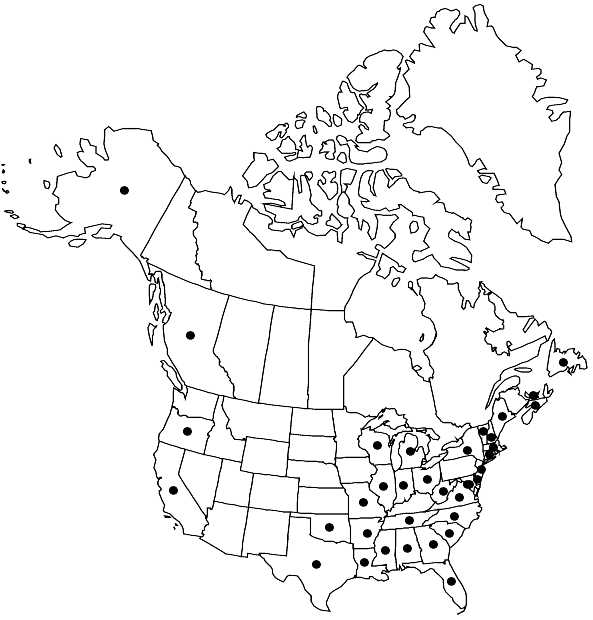Difference between revisions of "Sphagnum henryense"
Hedwigia 39: 107. 1900,.
FNA>Volume Importer |
imported>Volume Importer |
||
| (2 intermediate revisions by 2 users not shown) | |||
| Line 47: | Line 47: | ||
|publication year= | |publication year= | ||
|special status= | |special status= | ||
| − | |source xml=https:// | + | |source xml=https://bitbucket.org/aafc-mbb/fna-data-curation/src/2e0870ddd59836b60bcf96646a41e87ea5a5943a/coarse_grained_fna_xml/V27/V27_12.xml |
|genus=Sphagnum | |genus=Sphagnum | ||
|section=Sphagnum sect. Sphagnum | |section=Sphagnum sect. Sphagnum | ||
Latest revision as of 21:24, 5 November 2020
Plants moderate-sized to robust, capitulum typically flat, ± 5-radiate and with terminal bud slightly visible; green, pale green, to pale pinkish brown tinged with brown to reddish brown; forming carpets or low hummocks. Stems pale green to brown; superficial cortical layer with spiral reinforcing fibrils clearly visible, usually 4 or more pores per cell, comb-fibrils lacking on onterior wall. Stem leaves to 1.9 × 1 mm; rarely hemiisophyllous; hyaline cells non-ornamented, nonseptate or septate. Branches ± tapering to a point, leaves spreading to moderately imbricate. Branch fascicles with 2 spreading and 2 pendent branches. Branch stems with hyaline cells non-ornamented; funnel-like projections absent from interior end walls, large round pores on superficial walls. Branch leaves ovate, to 2.7 × 1 mm; hyaline cells on convex surface with numerous small round pores along the commissures, cell walls overlying chlorophyll cells often with a network of irregular worm like ridges although they may be lacking; chlorophyllous cells isosceles-triangular to narrowly ovate triangular in transverse section and just enclosed on convex surface,end wall not thickened. Sexual condition dioicous. Capsule with numerous pseudostomata. Spores 24–29 µm; surface finely papillose to nearly smooth.
Habitat: Poor to medium fens, common in wooded fens and pond margins
Elevation: low to moderate elevations
Distribution

B.C., Nfld. and Labr. (Nfld.), N.S., P.E.I., Ala., Alaska, Ark., Calif., Conn., Del., D.C., Fla., Ga., Ill., Ind., La., Maine, Md., Mass., Mich., Miss., Mo., N.H., N.J., N.Y., N.C., Ohio, Okla., Oreg., S.C., Tenn., Tex., Vt., Va., W.Va., Wis., Asia.
Discussion
The typical form of Sphagnum henryense is a large plant with a quite flat capitulum with a small terminal bud. Microscopically, typical material has distinct ridges on the branch leaf hyaline cells and relatively small and round pores on the branch leaf hyaline cell convex surface. Sphagnum palustre, which has the same branch leaf chlorophyll cell cross section, typically has smooth hyaline cell walls and hyaline cell pores that are larger and more elliptical in shape. However, Sphagnum species are plastic phenotypically and it is common to find plants that cannot be reliably assigned to either S. henryense or S. palustre. For example, some species of Sphagnum that are relatively easy to distinguish on other characteristics, such as S. papillosum, S. alaskense and S. affine, may occasionally completely lack any hyaline cell ornamentation or display it in reduced form. Since these can be distinguished on other characters, the species are still readily identifiable, but when S. henryense lacks the ornamentation, there is no other solid character to distinguish it from S. palustre. Thus, although we can find material from both North American coasts that has good ornamentation (R. E. Andrus 1980), there is much other material that looks in other respects like S. henryense but lacks the ornamentation. Barring taxonomy beyond microscopic examination, many collections of henryense/palustre will of necessity not be absolutely identifiable. Where their ranges overlap, mixed stands may often be found. We believe that the species are still good, but accurate delimitation of their distinctive ecologies and ranges will be very problematic.
Selected References
None.